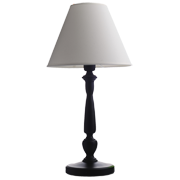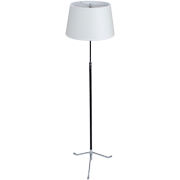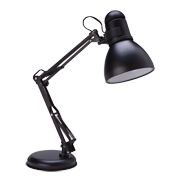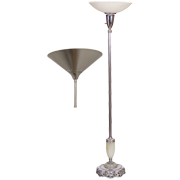
Plug-In Fixtures
As opposed to lighting fixtures that require electrical wiring, plug-in fixtures are easily connected to an electrical outlet. Most table lamps, floor lamps, torchieres, desk lamps, and nightlights are plugged in rather than hard wired. In addition to their fast installation, plug-in fixtures can easily be moved from one location to another as lighting needs change. To save energy, consider using timers or dimmers specifically made for plug-in fixtures.
Choose between table lamps, floor lamps, torchieres, and desk lamps based on the location and distribution of light that would be most helpful. Light can be distributed in many directions depending on size, shape, and materials of the lamp shade. Most plug-in fixtures can be adjusted to positions and angles that reduce glare. The best location is usually to the side and slightly behind the viewer.
Table lamps and floor lamps provide ambient lighting and task lighting. They complement the lighting from other fixtures and can balance brightness in a room or provide additional light for a specific area. Use a shade to shield the bulb from direct view. A torchiere is a floor lamp that directs all light upwards toward the ceiling and upper portion of the walls. These surfaces serve as reflectors, creating soft, shadowless indirect light. Torchieres work well in rooms with high ceilings and a light color, but avoid placing them in rooms with low ceilings and dark colored paint or wood paneling.
Desk lamps provide adjustable task light that can be aimed in a specific direction, for demanding visual tasks such as reading and writing. These tasks require higher levels of light than most other activities. Preventing shadows and glare is important to avoid discomfort and distraction. The placement, shade design, socket location, shielding, and choice of bulb are primary factors that determine quantity and quality of task light. Shadows can be an annoying problem when using a desk lamp for writing tasks. Place the desk lamp to the left for a right-handed person, and to the right for a left-handed person. Locate the desk lamp carefully to avoid reflections in a computer screen, but to provide enough light for reading documents. Also locate a desk lamp so that it provides some ambient light near a computer screen; this will increase comfort by balancing the contrast between the screen and the surrounding area.
Nightlights use low-wattage bulbs to provide light when ambient fixtures are off. Some plug-in nightlights are controlled by an on-off switch and others have dusk-to-dawn sensors (photosensors) that turn off automatically when no longer needed.
Cautions
- For safety, consider the weight and balance of fixtures, especially those containing CFLs. Also, consider stability when putting a heavier bulb (such as an LED) in a fixture designed for an incandescent bulb.
- Fixtures that contain high-wattage bulbs, particularly tubular-shaped halogen bulbs, can be a fire and burn hazard. Locate them a safe distance from flammable materials, and away from possible skin contact. Alternatively, use light sources such as CFLs or LEDs that do not generate as much heat as incandescent sources, while also saving energy.
- If the fixture is dimmable, check that CFL and LED products are rated as "dimmable" on the package.
- A common option for table lamps is a twisting switch that provides low, medium, and high output ("three-way"). This type of table lamp should be used with a compatible three-way bulb that is marked as such on the package. Avoid using a three-way bulb in a fixture that does not have this option, because the bulb will operate only at the highest wattage. If a single-wattage bulb is used in a table lamp designed for a three-way bulb, the single wattage bulb will operate only at two switch settings.
Example Patterns






